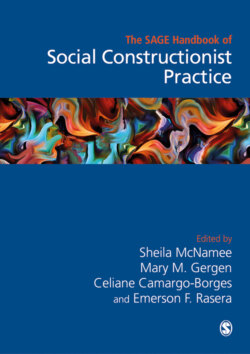Читать книгу The Sage Handbook of Social Constructionist Practice - Группа авторов - Страница 84
На сайте Литреса книга снята с продажи.
From the Visual to the Visionary
ОглавлениеGiven the longstanding assumption that photographs provide the unvarnished truth about their subject matter, it is surprising that outside the tradition of visual sociology, so little use has been made of photography in the social sciences. The performative movement lends new life to this medium, but with an understanding of photography as both interpretive and value invested (Allen, 2011; Allen, 2012; Miller, 2016). To sample the innovative use of the medium, Newbury and Hoskins (2010) gave adolescent girls, who were drug users, digital cameras to explore and portray their life conditions and potentials. In their photovoice work on Parkinson's disease, Hermanns et al. (2015) asked their participants to take photos of everyday challenges related to the disease, and then engaged them in dialogue about the photos. Such combining of photography with other forms of representation is increasingly common. Mannay (2010) has combined photos, mapping, and collage production in her study of the experiences of mothers and daughters in a social housing estate. Also see Lawrence-Lightfoot and Davis for their pioneering work on portraiture methodology (1997). Brooks (2017) has elaborated on the importance of portraiture in its contributions of aesthetics to performative inquiry.
The development of digital video devices has been a strong invitation to explore filmic representation in the social sciences. The aforementioned works of Wiseman and Livingston opened the door. Kip Jones’ prize-winning film, Rufus Stone (https://vimeo.com/109360805) is testimony to a continuing tradition of excellence. The project was based on narrative materials collected and synthesized by Jones. The aim was also to empower older lesbians and gay men in rural areas through participatory action research. Kenneth Gergen (2018) has turned to video to create what he calls an evocative ethnography of life in the contemporary digital world. Still other scholars have turned directly to You Tube to reach large audiences of viewers. For example, Kitrina Douglas (2012) offers performative videos in anti-psychiatry and feminism in song form. Other efforts can be found in the multi-media journal, Liminalities.
These various endeavors in textual, embodied, and visual performance scarcely exhaust the range of innovative explorations now extant. For example, Blumenfeld-Jones (2008) describes the uses and potentials of dance in performative social science; Glenda Russell and Janis Bohan (1999) have demonstrated the power of choral music in the politics of change. Bartlett (2013) has used cartoons as a form of inquiry. Kuttner et al. (2018) have combined cartoons with rap music as part of their research work. There are also numerous ways in which scholars have combined various forms of representation to achieve their ends. As poetic expression is accompanied by music, for example, the audience's experience may be enriched. The combinations and permutations resulting from integrations across the realm of artistic expression may be limitless.
